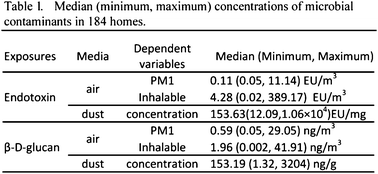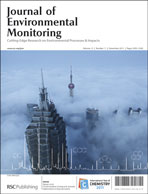Influence of home characteristics on airborne and dustborne endotoxin and β-d-glucan
Abstract
The aim of this study was to assess the associations between airborne and dustborne microbial contaminants (endotoxin and β-D-glucan) and estimate the effects of home characteristics on exposure levels of these microbial contaminants. Endotoxin and β-D-glucan concentrations in airborne inhalable particles, airborne PM1 (<1 μm) and vacuumed dust from 184 residential homes were determined using specific Limulus amebocyte assays. Home characteristics were recorded by visual inspection and questionnaires. Linear regression and correlation analyses were performed. Inhalable endotoxin correlated with dust endotoxin (r = 0.34, p < 0.001) and PM1 endotoxin (r = 0.33, p < 0.001). Inhalable β-D-glucan correlated with dust β-D-glucan (r = 0.18, p < 0.01), but not with PM1 β-D-glucan. Significant correlation was also found between PM1 and dust concentrations for endotoxin (r = 0.26, p < 0.001), but not for β-D-glucan. Multivariate regression analyses showed only one significant association between airborne contaminants and environmental characteristics: inhalable β-D-glucan was positively associated with relative humidity with an effect size (change in the dependent variable corresponding to a unit increase in the independent variable) of 2.32 and p < 0.05. In contrast, several associations were found between dust concentrations and environmental characteristics. Dust endotoxin was positively associated with temperature (2.87, p < 0.01) and number of inhabitants (2.76, p < 0.01), whereas dust β-D-glucan was inversely associated with the presence of dogs (−2.24, p < 0.05) and carpet (−3.05, p < 0.01) in the home. In conclusion, dustborne contaminants were more strongly affected by home characteristics than airborne contaminants. Furthermore, even though statistically significant, the correlations between airborne and dustborne contaminants were weak. This indicates that airborne concentrations cannot be reliably predicted based on dustborne concentrations.


 Please wait while we load your content...
Please wait while we load your content...